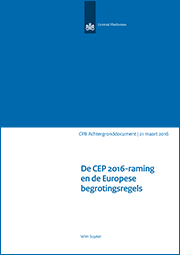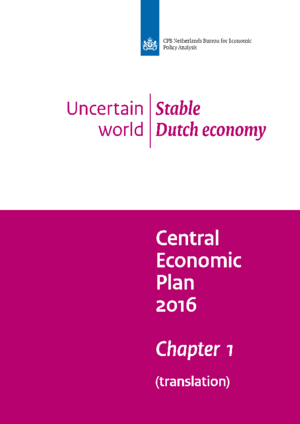Central Economic Plan (CEP) 2016
Central Economic Plan 2016 published, reinstating border controls Schengen countries will hurt the economy
CPB calculations of trade impacts show a structural GDP loss (by 2020) of 110 billion euros for the EU as a whole, and 9 billion for the Netherlands; a respective decrease in GDP of 0.7% and 1.3%. The larger GDP loss for the Netherlands is due to the greater openness of the Dutch economy. This is one of the conclusions of the Central Economic Plan 2016 (CEP), published today by CPB Netherlands Bureau for Economic Policy Analysis.
Go straight to the data.
On 7 March 2016, CPB Policy Brief 2016/03 (in Dutch) was published containing Chapter 1 of the CEP as well as the main economic indicators. The full report is now also available, containing more background information and details on the international economy and the Dutch economy, government finances and purchasing power projections for 2016 and 2017. The CEP traditionally contains a number of text boxes in which certain issues are elaborated. In addition to the text box on the impact of reinstating border controls, there are those on the uncertainties about the projections (shown in fan charts), the relationship between the development of the wedge and the economy, the downward impact of the financial sector on the labour income share, the large share of the government civil service with executive tasks, and the way in which the increasing influx of asylum seekers is incorporated in the projections. A CPB Background Document (in Dutch) to the CEP is also published, with information on the projections and the European budgetary regulations.
Macro economic indicators (see also the Press Release of 7 March)
The Dutch economy is projected to grow by 1.8% this year and 2.0% next year. Basic growth levels in both years are comparable; the lower revenues from natural gas sales will dampen this year’s growth by 0.2%. The growth in production is coupled with an increase in employment which, in turn, is driven by the growth in the market sector. Labour supply is also increasing, but less so than employment. On balance, there will be a slight decrease in unemployment, down to 6.3% in 2017. Purchasing power will increase this year by 2.3% due to the low inflation level, the resulting substantial rise in real wages, and the reduction in financial burden because of the 5-billion-euro package of measures. For next year, median household purchasing power is projected to grow by 0.2%. Because of the continuing moderate economic recovery, the government deficit will decrease from 1.9% of GDP this year, to 1.7% in 2016 and 1.2% in 2017. The continuing economic recovery and decrease in unemployment result in lower expenditure on unemployment benefits. Lower natural gas revenues, caused by lower production and a lower price level, will have an attenuating effect on deficit reduction.
To the main indicators.
In the eurozone, growth is progressing slowly but surely, with 1.6% this year and 1.7% in 2017. The world trade relevant for the Netherlands will gradually increase to 4.4% by next year. Price levels are determined by the recent continuing drop in resource prices and particularly the oil price, a major cause of the low inflation rate in many countries.
Related
- Centraal Economisch Plan 2016 (Dutch)
Downloads

Lees het Centraal Economisch Plan 2016.
Een begroting is in evenwicht als het structurele EMU-saldo minimaal gelijk is aan de middellangetermijndoelstelling (MTO). Voor de preventieve arm zijn de volgende vier variabelen relevant: het feitelijke EMU-saldo, het structurele EMU-saldo, de overheidsschuld en de (gecorrigeerde) overheidsuitgaven.
De belangrijkste norm is dat Nederland het feitelijke overheidstekort beneden de 3% bbp houdt. Nederland zou weer met een buitensporigtekortprocedure te maken kunnen krijgen als blijkt dat het feitelijke overheidstekort in het afgelopen jaar meer dan 3% bbp bedroeg, of als het geraamde tekort meer dan 3% bbp is. In alle ramingsjaren blijft het tekort minder dan 3% bbp. Als aan de 3%-norm is voldaan, wordt getoetst op toegroeien naar begrotingsevenwicht. Voor Nederland dient het structurele EMU-saldo uiteindelijk minimaal gelijk te zijn aan zijn middellangetermijndoelstelling van het EMU-saldo (MTO): -0,5% bbp. In 2015 en de twee ramingsjaren is het saldo negatiever dan de MTO, ook inclusief de toegestane onzekerheidsmarge. De begroting is daarmee niet in evenwicht.
Authors

Lees het Centraal Economisch Plan 2016 (maart 2016) of de Macro Economische Verkenning 2017 (september 2016).
Authors
- Main Conclusions
- Fan Charts
- The table 'Main economic indicators', 2014-2017
- Graph 'Economic growth in the Netherlands, 2008-2017'
- Related Publication
Main conclusions
Read the accompanying press release.
Fan Charts
Take a look at the Fan Charts.
Table 'Main economic indicators', 2014-2017
| 2014 | 2015 | 2016 | 2017 | |
|---|---|---|---|---|
| Relevant world trade volume goods and services (%) |
3.9 |
3.6 |
3.8 |
4.4 |
| Export price competitors (goods and services, non-commodities, %) |
-1.3 |
6.2 |
-1.3 |
0.2 |
| Crude oil price (dollar per barrel) |
99.0 |
52.5 |
31.7 |
37.7 |
| Exchange rate (dollar per euro) |
1.33 |
1.11 |
1.09 |
1.09 |
| Long-term interest rate the Netherlands (level in %) |
1.5 |
0.7 |
0.6 |
0.6 |
| 2014 | 2015 | 2016 | 2017 | |
|---|---|---|---|---|
| Gross domestic product (GDP, economic growth, %) |
1.0 |
1.9 |
1.8 |
2.0 |
| Consumption households (%) |
0.0 |
1.6 |
1.6 |
2.0 |
| Consumption general government (%) |
0.3 |
-0.3 |
2.0 |
0.2 |
| Capital formation including changes in stock (%) |
2.7 |
7.2 |
6.0 |
4.2 |
| Exports of goods and services (%) |
4.0 |
4.2 |
3.6 |
4.1 |
| Imports of goods and services (%) |
4.0 |
4.9 |
5.0 |
4.5 |
| 2014 | 2015 | 2016 | 2017 | |
|---|---|---|---|---|
| Price gross domestic product (%) |
0.8 |
0.5 |
1.1 |
0.9 |
| Export price goods and services (non-energy, %) |
-0.7 |
0.7 |
-0.8 |
0.5 |
| Import price goods (%) |
-3.1 |
-5.5 |
-7.3 |
1.8 |
| Inflation, harmonised index of consumer prices (hicp, %) |
0.3 |
0.2 |
0.3 |
1.0 |
| Contractual wages market sector (%) |
1.0 |
1.2 |
1.5 |
1.7 |
| Purchasing power, static, median all households (%) |
1.4 |
1.0 |
2.3 |
0.2 |
| 2014 | 2015 | 2016 | 2017 | |
|---|---|---|---|---|
| Labour force (%) |
-0.4 |
0.4 |
0.3 |
1.2 |
| Active labour force (%) |
-0.6 |
1.0 |
0.7 |
1.5 |
| Unemployment (in thousands of persons) |
660 |
614 |
580 |
570 |
| Unemployed rate (% of the labour force) |
7.4 |
6.9 |
6.5 |
6.3 |
| 2014 | 2015 | 2016 | 2017 | |
|---|---|---|---|---|
| Production (%) |
1.9 |
2.7 |
2.3 |
2.6 |
| Labour productivity (hours, %) |
1.4 |
1.3 |
0.8 |
1.4 |
| Employment (hours, %) |
0.5 |
1.4 |
1.4 |
1.2 |
| Compensation per hour (%) |
1.7 |
1.3 |
2.2 |
2.1 |
| Labour share in enterprise income (level in %) |
79.2 |
77.7 |
77.8 |
78.2 |
| 2014 | 2015 | 2016 | 2017 | |
|---|---|---|---|---|
| Private savings (% of disposable household income) |
0.8 |
0.9 |
2.2 |
1.6 |
| Current-account balance (level in % GDP) |
10.6 |
11.1 |
11.1 |
10.5 |
| 2014 | 2015 | 2016 | 2017 | |
|---|---|---|---|---|
| General government financial balance (% GDP) |
-2.4 |
-1.9 |
-1.7 |
-1.2 |
| Gross debt general government (% GDP) |
68.2 |
66.3 |
65.4 |
64.1 |
| Taxes and social security contributions (% GDP) |
37.5 |
37.5 |
37.5 |
37.7 |
CPB uses as of CEP 2016 hours worked instead of FTE as standard for labour input. This has implications for the figures on wage rates and employment. A CPB Background Document with more information is available (only in Dutch).
Economic growth in the Netherlands, 2008-2017


